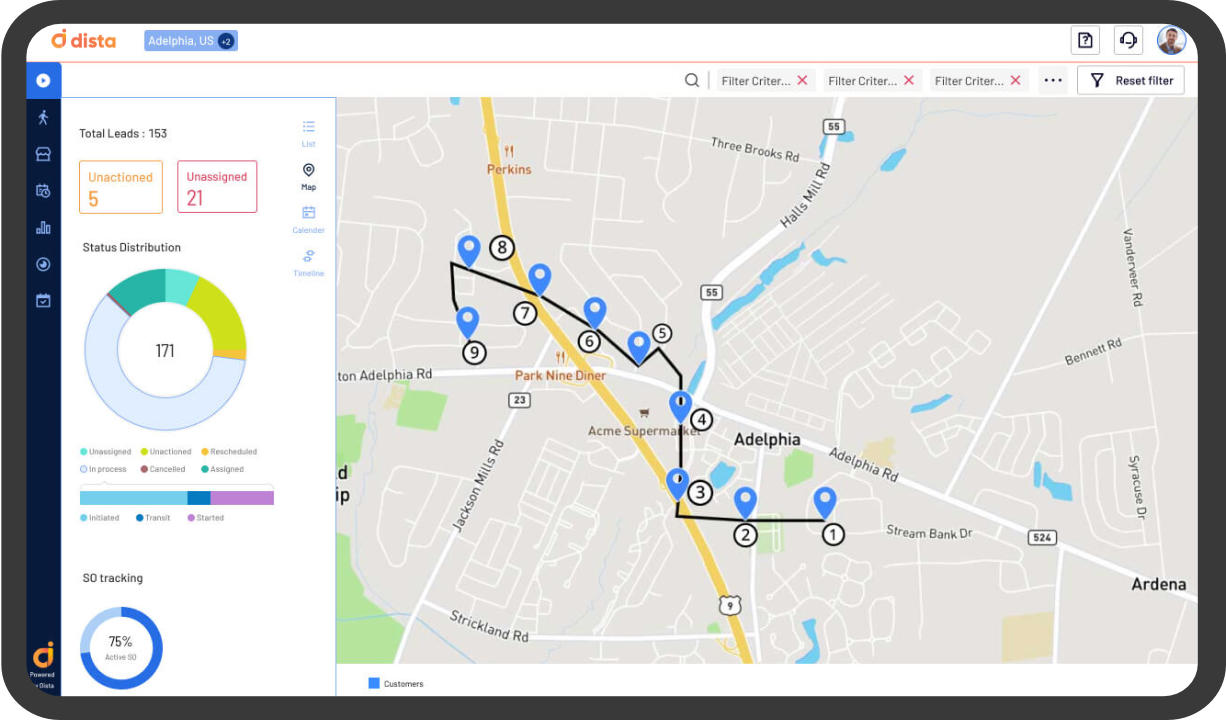Effective sales territory management can boost revenue by up to 7% without adding new sales reps, as per a report from Harvard Business Review. Yet, many businesses struggle with inefficient territories, leading to poor coverage, workload imbalances, and missed opportunities. A well-structured sales territory plan ensures fair distribution of prospects, maximizes sales coverage, and enhances customer engagement.
Enterprises across industries use data-driven territory management to assign the right sales reps to the right regions. Let’s explore the essentials of sales territory management, its benefits, and how businesses can design optimized territories for better sales performance.
What is Sales Territory Management?
A sales territory is a geographical area comprising prospects and customers. They are assigned to sales teams and are created based on multiple parameters like area, demographics, density, and more. Sales territory management is a scientific and systematic process of designing territories and mapping them to sales agents.
Benefits of Sales Territory Management
1. Balanced Workload Distribution
Creating equitable territories ensures a fair distribution of workload among sales reps by assigning them based on customer potential, market demand, and team capacity. As territories expand and business priorities change, it is essential to realign them based on the new objectives.
A territory management software automatically balances accounts by considering your business constraints and variables. According to a recent report, optimizing territory design can increase sales by 2-7% without any change in total resources or sales strategy.
2. Enhanced Customer Coverage
A territory management software with location intelligence at its core, like Dista, performs geospatial analysis by using location-based data to define optimal sales territories. It enables businesses to visualize customer distribution, identify untapped markets and high-potential areas, and optimize sales rep allocation.
By analyzing demographics, travel time, and market potential, companies can ensure no region is underserved or oversaturated.
3. Better Customer Engagement
Optimal workload balance helps sales reps spend more time engaging with customers, finding upsell/cross-sell opportunities, and reducing travel time. Strategic agent-to-territory mapping boosts customer engagement, builds trust, and improves response times, thereby elevating overall customer satisfaction.
7 Steps to Create a Sales Territory Plan
Having a systematic approach to sales territory management is vital to maximize sales productivity, expand market reach, and boost customer engagement. Here’s a step-by-step guide to performing effective sales territory planning.
1. Identify and Define Goals
The first step is identifying and defining business goals before designing territories, as it helps understand what the sales team plans to accomplish with the sales territory plan.
2. Analyze and Segment Customers
Analyzing and segmenting your customers involves dividing the target market into distinct groups based on geographic boundaries, behavioral demographics, revenue potential, and more. This process ensures focused and tailored strategies for each segment, maximizing the effectiveness of sales efforts.
3. Evaluate Competition
Identify your competitors in each territory and understand their strengths and weaknesses. Visualize and evaluate their market presence across certain regions with the help of spatial analytics software. Assess them by considering factors like product pricing, use cases, market positioning, reviews, and more.
4. Establish Goals and Target
Set measurable, specific, and achievable targets for the sales team that help motivate and be productive. Formulate benchmarks to set performance standards that measure progress toward achieving the established goals. These benchmarks act as checkpoints, allowing businesses to evaluate the effectiveness of the territory plan.
5. Allocate Resources and Assign Territories
Now that you have done the initial groundwork and decided on your territories, it’s time to allocate sales resources to them. Territory assignment to sales reps should be transparent and fair. Territory management software balances and distributes resources to improve sales coverage.
6. Set up a Routing Plan
Schedule and create a routing plan for your outside sales teams to streamline their daily visits. Create sales beat plans for sales teams considering multiple factors like location, serviceable area, skillset, and more.

7. Monitor and Evaluate Performance
Track and measure essential sales KPIs to make strategic data-driven decisions. Continuous monitoring provides real-time insights into sales performance, customer feedback, and market dynamics, enabling businesses to adapt swiftly to changing market conditions.
How Dista Optimizes Sales Territories?
Dista Sales, a location-first field force management software, helps enterprises across industries optimize sales territory management with its patented clustering algorithm. It enables businesses to create balanced territories by analyzing factors such as customer locations, visit frequency, travel distance, and field agent capacity.
Leaders can run multiple simulations to design equitable territories, ensuring fair workload distribution and optimal coverage. The algorithm clusters high-potential areas while minimizing overlaps and inefficiencies. Automated field agent assignment considers proximity, availability, experience, and workload capacity, improving efficiency. This data-driven approach enhances customer coverage, boosts sales productivity, and streamlines field operations.
Want to strengthen your sales territory management? Contact us and see our platform in action.






